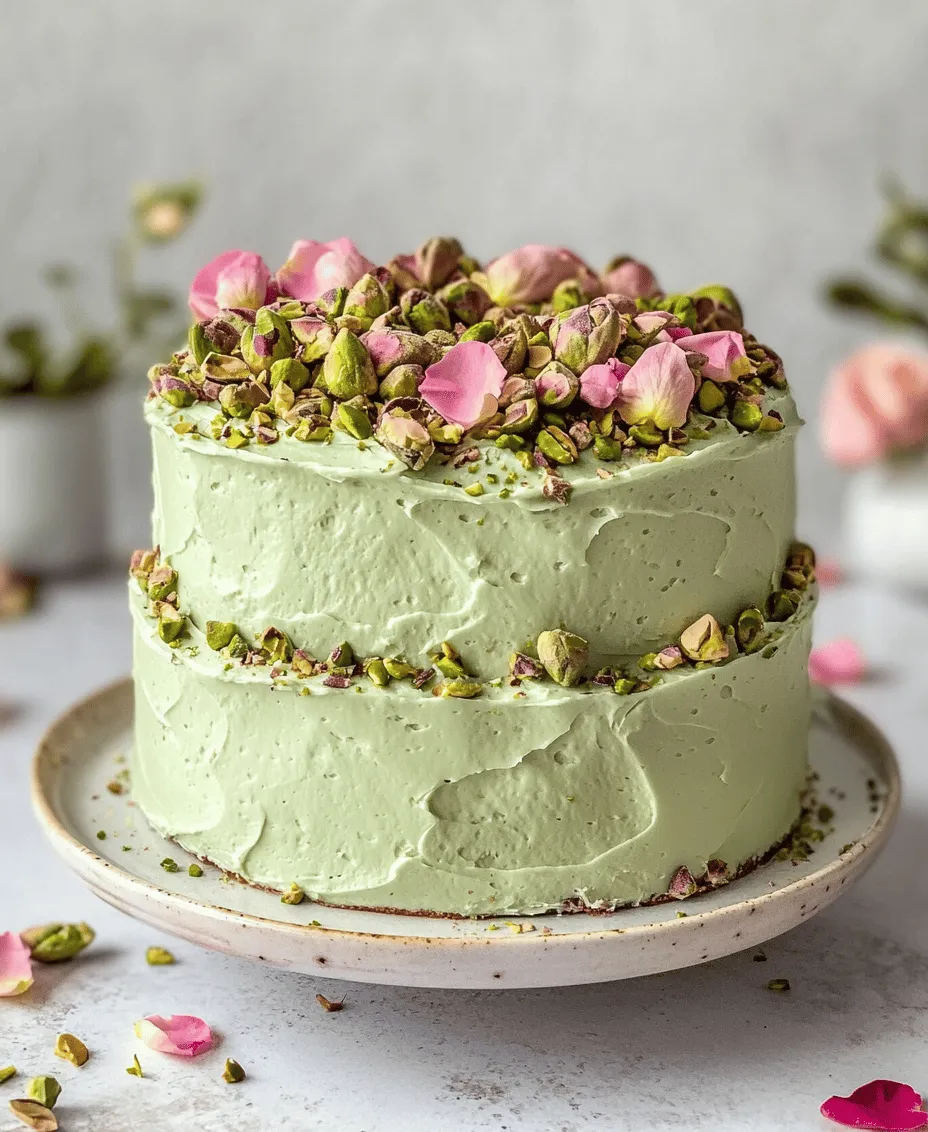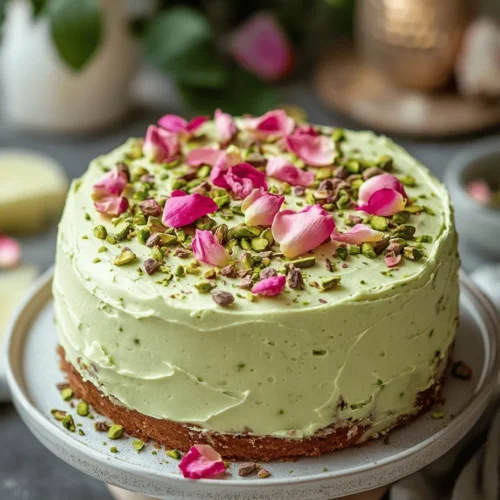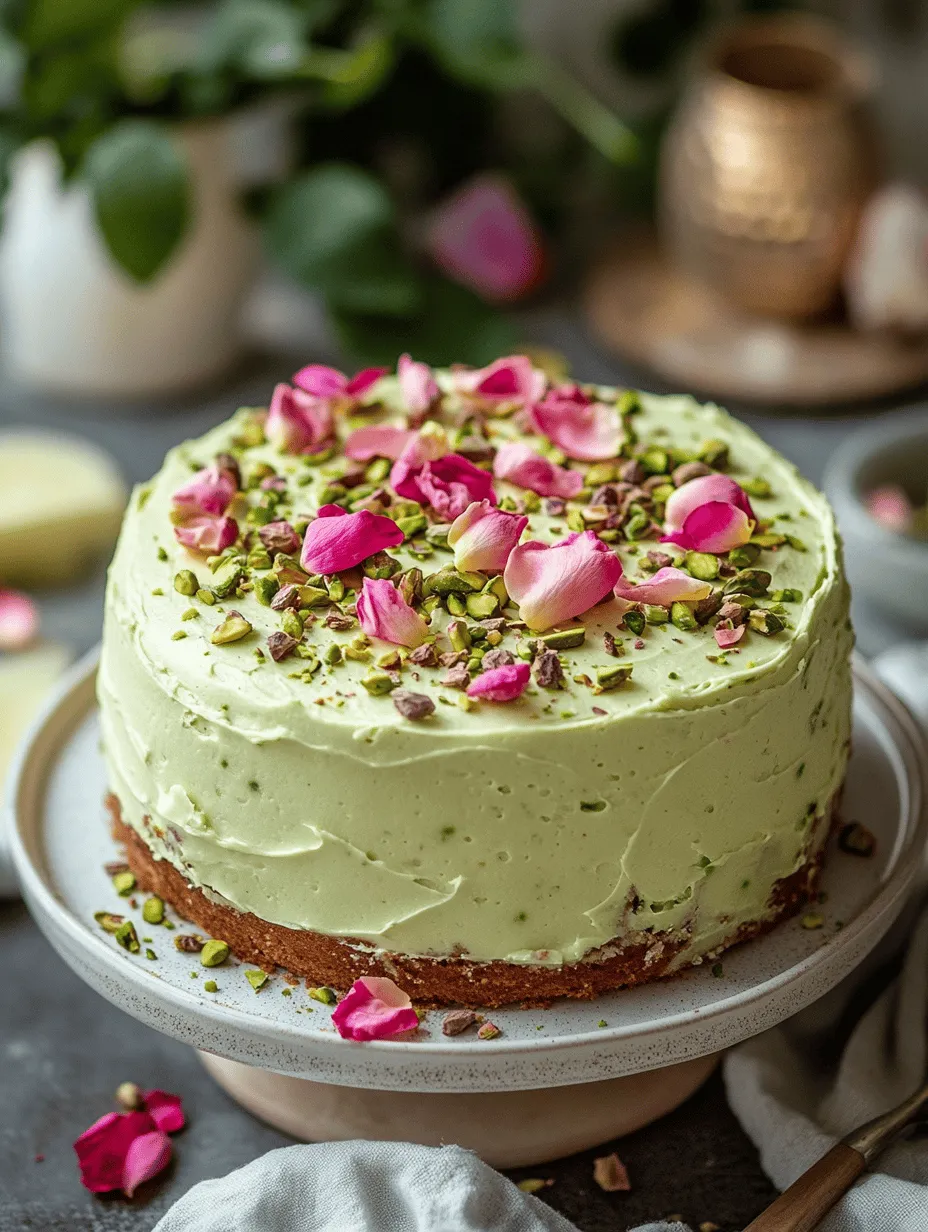Introduction
Elegant desserts have a special place in culinary traditions around the world, often gracing tables during celebrations, weddings, and special occasions. Their intricate designs and unique flavors not only tantalize the taste buds but also create lasting memories. Among these exquisite desserts is the Rosewater Pistachio Cake, a delightful treat that stands out for its beautiful balance of flavor and texture. This cake, with its soft crumb and aromatic essence, is perfect for anyone looking to impress guests or simply indulge in a luxurious dessert.
The Rosewater Pistachio Cake is a sophisticated blend of flavors that combines the nutty richness of pistachios with the delicate floral notes of rosewater. This unique combination creates a cake that is not only visually stunning but also offers an unforgettable taste experience. As you slice into the cake, the vibrant green of the ground pistachios pairs beautifully with the pale hue of the cake, evoking thoughts of lush gardens and blooming flowers.
Historically, rosewater has been a cherished ingredient in various culinary traditions, especially in Middle Eastern and Indian cuisines. Its fragrant and slightly sweet profile adds depth to desserts, making it a beloved choice for many. Meanwhile, pistachios have been enjoyed for centuries, celebrated not only for their rich flavor but also for their health benefits. Together, these ingredients create a cake that is both elegant and deeply rooted in history, making it a standout choice for your next gathering.
Understanding the Ingredients
To create a Rosewater Pistachio Cake that captures the essence of elegance, it is essential to understand the role of each ingredient, as they contribute significantly to the overall flavor and texture of the cake.
All-Purpose Flour
All-purpose flour serves as the foundation of the cake, providing the necessary structure to hold the cake together. The protein content in all-purpose flour allows for the formation of gluten, which gives the cake its desirable texture. A fine balance in flour measurement is crucial; too much flour can lead to a dense cake, while too little can result in a cake that does not rise properly.
Sugar
Sugar plays a vital role in the cake by adding sweetness and moisture. It not only enhances the flavor but also contributes to the cake’s texture, making it tender. In addition, sugar helps to create a beautiful golden crust during baking, adding to the cake’s visual appeal.
Unsalted Butter
Unsalted butter is a key ingredient that adds richness and flavor to the cake. The fat in butter helps to create a tender crumb and contributes to the cake’s overall moistness. Using unsalted butter allows for better control over the salt content in the recipe, ensuring a well-balanced flavor profile.
Eggs
Eggs act as a binding agent in the cake, helping to hold all the ingredients together. They also provide moisture and richness, contributing to the cake’s tender texture. The proteins in eggs help the cake to rise and stabilize during baking, making them an essential component of this recipe.
Ground Pistachios
Ground pistachios are the star ingredient of this cake, infusing it with a nutty flavor and a delightful texture. Not only do they add a beautiful green hue to the batter, but they also enhance the overall taste experience. Pistachios are packed with nutrients, offering health benefits such as heart-healthy fats, protein, and antioxidants.
Rosewater
Rosewater is the ingredient that gives the cake its unique floral aroma and taste. A little goes a long way, as its potent essence can overpower if used in excess. Rosewater has a rich history in culinary traditions, often associated with celebrations and special occasions, which adds to the cake’s elegance. It pairs beautifully with pistachios, amplifying the overall flavor profile of the dessert.
Baking Powder and Baking Soda
These leavening agents are crucial for creating the light and airy texture of the cake. Baking powder and baking soda work together to create carbon dioxide bubbles during baking, causing the cake to rise. Properly measuring these ingredients ensures that the cake achieves its desired height and softness.
Salt
While salt is often underestimated, it plays an essential role in enhancing the flavors of the cake. A small amount of salt balances the sweetness of the sugar and enriches the overall taste, making every bite more satisfying.
Whole Milk
Whole milk adds moisture and richness to the cake batter, ensuring a tender crumb. The fats in whole milk contribute to the cake’s overall flavor and texture, making it a key ingredient in achieving the perfect Rosewater Pistachio Cake.
Lemon Zest
Lemon zest is a delightful addition that brings brightness and acidity to the cake. The fresh citrus notes help to balance the rich flavors of the pistachios and rosewater, creating a harmonious blend that elevates the cake to new heights.
The Allure of Rosewater and Pistachios
The combination of rosewater and pistachios is not only a feast for the taste buds but also a celebration of history and culture. Rosewater has been used in desserts for centuries, particularly in Persian and Indian cuisines, where it symbolizes love and beauty. Its presence in sweets like baklava and gulab jamun has made it a staple in festive celebrations, often associated with the sharing of joy and happiness.
Pistachios, on the other hand, have a long-standing reputation as a luxurious nut, often referred to as the “smiling nut” due to their vibrant green color and delightful taste. Their health benefits, including heart health and antioxidant properties, have only added to their appeal. The combination of these two ingredients is not just aesthetically pleasing but also deeply rooted in tradition, making the Rosewater Pistachio Cake a meaningful choice for special occasions.
The complementary nature of rosewater and pistachios cannot be understated; the nutty richness of pistachios enhances the floral notes of rosewater, creating a delightful symphony of flavors. Each bite of the cake is a testament to the thoughtfulness of its ingredients, making it a perfect centerpiece for any gathering.
Step-by-Step Instructions
Now that we have explored the fascinating elements that come together to create the Rosewater Pistachio Cake, it’s time to delve into the preparation process. A successful cake begins with proper planning and preparation, ensuring that each step is executed flawlessly.
Prepping the Oven and Cake Pans
1. Preheat Your Oven: Begin by preheating your oven to 350°F (175°C). Proper preheating is essential for even baking and a well-risen cake.
2. Prepare Your Cake Pans: Grease and flour two 9-inch round cake pans thoroughly, ensuring that the cakes release easily after baking. Alternatively, you can line the bottoms with parchment paper for added assurance. Dusting with flour will create a barrier that prevents sticking, allowing for a clean release.
3. Gather Your Ingredients: Before diving into mixing, ensure that all your ingredients are at room temperature. This includes the butter, eggs, and milk. Room temperature ingredients blend together more smoothly, resulting in a more cohesive batter.
4. Measure Carefully: Accurate measurements are the key to success in baking. Use a kitchen scale for precision or measuring cups for dry ingredients, and liquid measuring cups for wet ingredients.
5. Prepare the Pistachios: If you haven’t already, finely grind the pistachios in a food processor until they resemble a coarse flour. Be careful not to over-process, as this can turn them into pistachio butter.
With the oven preheated and the cake pans ready, you are well on your way to creating a stunning Rosewater Pistachio Cake. The next steps will guide you through mixing the ingredients and baking the cake to perfection. Stay tuned for the continuation of this delightful recipe, where we will combine these ingredients to create a masterpiece that is sure to impress!

Creaming Butter and Sugar: Importance of Texture
The first step in creating the perfect Rosewater Pistachio Cake is creaming the butter and sugar together. This process is crucial because it incorporates air into the mixture, resulting in a light and fluffy texture. Start by using room-temperature unsalted butter, which allows for easier blending. In a mixing bowl, combine the butter and granulated sugar, then beat them together using an electric mixer on medium speed for about 3-5 minutes until the mixture is pale and fluffy. This process not only contributes to the cake’s rise but also enhances its overall flavor, creating a tender crumb that melts in the mouth.
The Egg Incorporation Process: Why It Matters
Following the creaming of butter and sugar, it’s essential to incorporate the eggs properly. Add the eggs one at a time, mixing well after each addition. This gradual incorporation is crucial as it allows the emulsification of fat and liquid, resulting in a stable batter. Overmixing at this stage can lead to a dense cake, so once the eggs are fully combined, stop mixing. If desired, you can add a splash of vanilla extract alongside the eggs to deepen the flavor profile of the cake.
Mixing Dry and Wet Ingredients: The Science Behind It
Next, it’s time to combine the dry and wet ingredients. In a separate bowl, whisk together the all-purpose flour, baking powder, and a pinch of salt. The baking powder is key here, as it ensures the cake rises beautifully. When you’re ready to mix, alternate adding the dry ingredients and the prepared wet ingredients (which include the milk and rosewater) into the butter-sugar-egg mixture. Start with the dry ingredients, then add some of the wet, mixing gently after each addition. This method prevents overmixing and ensures that the flour is just hydrated enough to form a batter without developing gluten too much, which can lead to a tough cake.
Dividing the Batter and Baking Tips
Once your batter is ready, divide it evenly between two prepared 9-inch round cake pans. This ensures even baking and makes it easier to layer the cakes later. Smooth the tops with a spatula for a uniform surface. Preheat your oven to 350°F (175°C) and bake the cakes for 25-30 minutes, or until a toothpick inserted in the center comes out clean. Keep an eye on them during the last few minutes of baking; overbaking can dry out your cake. After removing them from the oven, let the cakes cool in the pans for about 10 minutes before transferring them to a wire rack to cool completely.
Cooling and Frosting the Cake: Techniques for Best Results
Cooling the cakes completely is critical before frosting. If they are even slightly warm, the frosting can melt and slide off, ruining your presentation. Once cooled, level the tops of the cakes with a serrated knife if necessary, ensuring an even surface for stacking.
When it comes to frosting the cake, choose a frosting that complements the delicate flavors of rosewater and pistachio. A cream cheese frosting, with its tangy flavor, can balance the sweetness and add a delightful richness. For a lighter option, whipped cream can be used, which creates an airy texture that pairs beautifully with the cake. If you prefer a traditional buttercream, consider infusing it with additional flavors such as almond or vanilla to enhance the overall profile of the cake.
Frosting and Decoration Ideas
Frosting Options
1. Cream Cheese Frosting: Combine cream cheese, unsalted butter, powdered sugar, and a splash of vanilla extract. Beat until smooth and creamy. This tangy frosting pairs exceptionally well with the floral notes of the cake, enhancing its elegance.
2. Whipped Cream: For a lighter touch, whip heavy cream with a bit of sugar until soft peaks form. This simple frosting allows the cake’s flavors to shine through while providing a delightful contrast in texture.
3. Buttercream Variations: You can create different buttercream flavors by adding extracts like almond or even a hint of rosewater. For a more vibrant color, consider adding a drop of food coloring or blending in some finely ground pistachios for a unique twist.
Garnishing Ideas
To elevate your Rosewater Pistachio Cake’s presentation, garnish it with fresh pistachios, lightly crushed for a pop of color and texture. Edible rose petals can also be scattered on top, adding a visually stunning element that emphasizes the cake’s floral notes. For an added touch of elegance, consider drizzling a rosewater syrup or a simple icing glaze over the top before serving.
Creative Serving Suggestions
For an elegant presentation, consider serving the cake on a beautiful cake stand. You can slice the cake into generous portions and plate it with a side of fresh berries or a scoop of rose-flavored ice cream. Alternatively, serve it with a drizzle of honey or a sprinkle of powdered sugar for an extra touch of sweetness.
Pairing Suggestions
To enhance the experience of enjoying your Rosewater Pistachio Cake, consider pairing it with beverages that complement its delicate flavors.
Tea Options: Floral and herbal tea blends, such as chamomile or jasmine, can enhance the floral notes of the cake. A light green tea with hints of mint can also offer a refreshing contrast.
Coffee: Opt for a light roast coffee that won’t overpower the cake’s flavors. A subtly flavored coffee, such as a vanilla or hazelnut blend, can enhance the overall tasting experience.
Dessert Wines: Sweet wines, particularly those with floral notes like Moscato or a light Riesling, pair wonderfully with this cake, adding a sophisticated touch to your dessert experience.
The Perfect Occasion for Rosewater Pistachio Cake
This elegant Rosewater Pistachio Cake is perfect for a variety of occasions. Its sophisticated flavors and beautiful presentation make it an ideal centerpiece for celebrations such as weddings, birthdays, and festive gatherings. The unique combination of pistachios and rosewater is reminiscent of many cultural traditions, making it a fitting choice for events celebrating heritage and family.
Imagine serving this cake at a summer garden party, where the floral notes can be enjoyed alongside the sweet aroma of blooming roses and fresh herbs. It’s also a wonderful addition to holiday tables, offering a refreshing alternative to more traditional desserts.
Conclusion
In conclusion, the Rosewater Pistachio Cake stands out not only for its delightful flavors but also for its stunning visual appeal. This cake artfully combines the richness of pistachios with the delicate floral notes of rosewater, creating a dessert that is both sophisticated and inviting. Whether you choose to serve it at a special occasion or enjoy it as a delightful treat for yourself, this cake embodies the joy of culinary art and cultural heritage. Embrace the experience of making and sharing this exquisite dessert, and let it become a cherished recipe in your repertoire, inviting others to celebrate life’s special moments with a slice of elegance.


